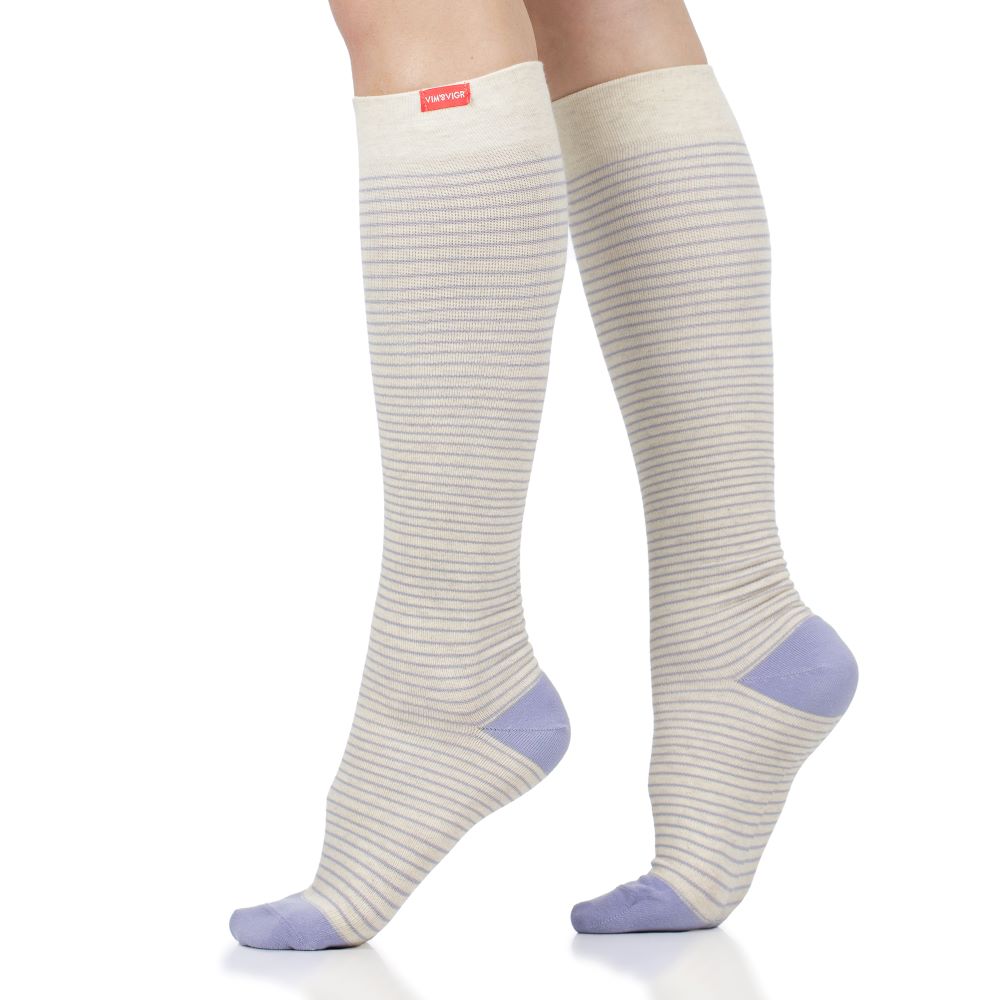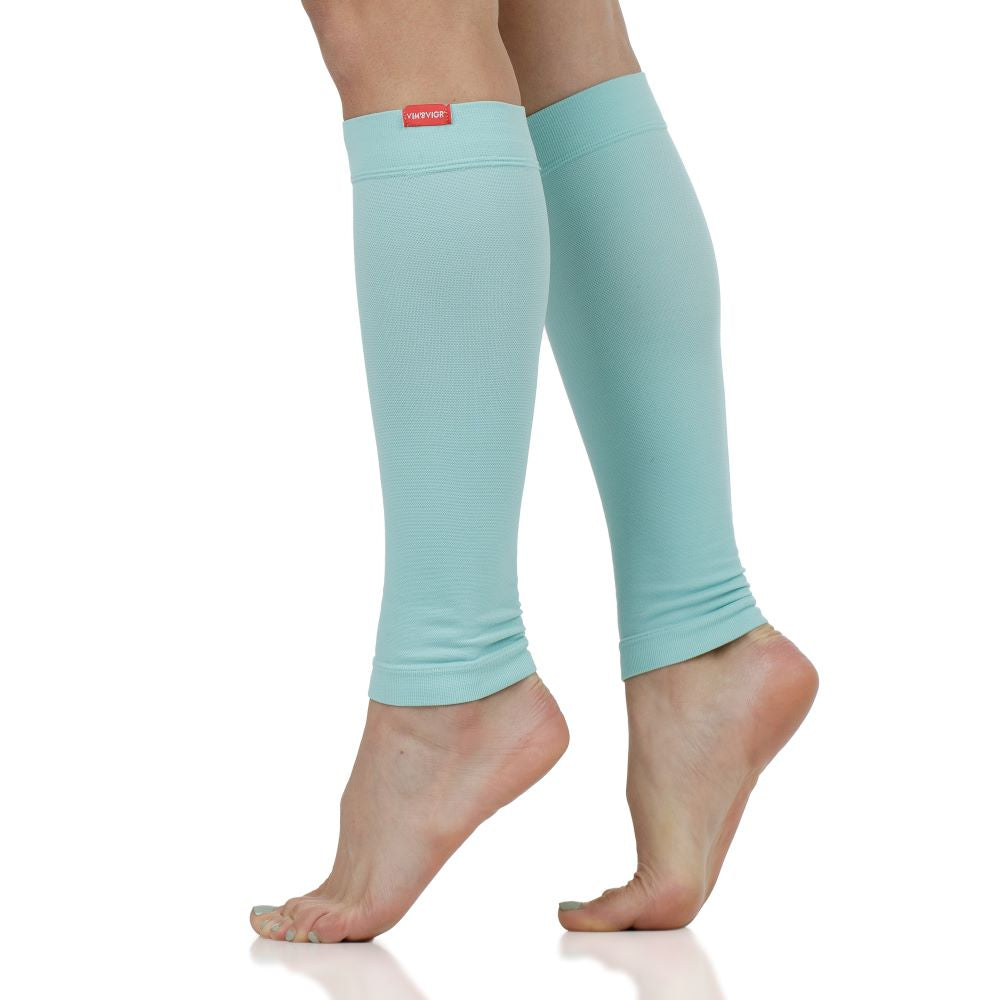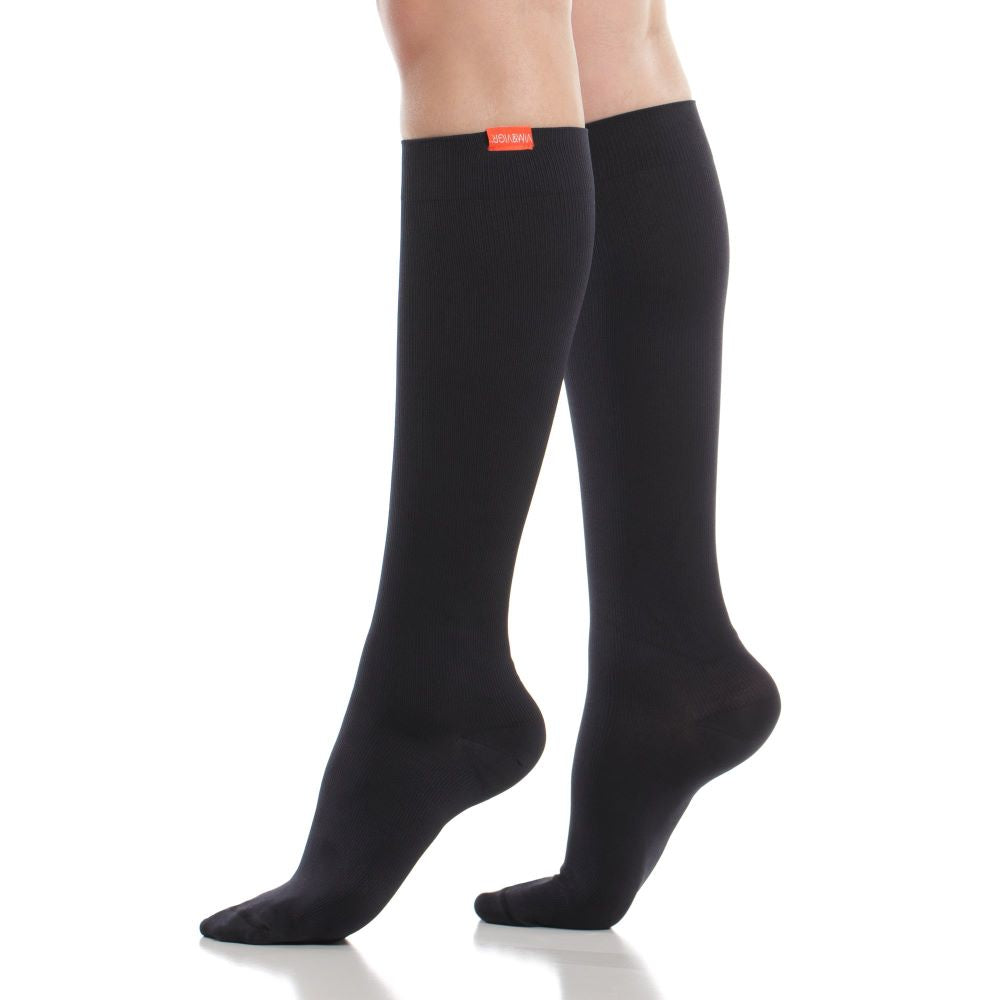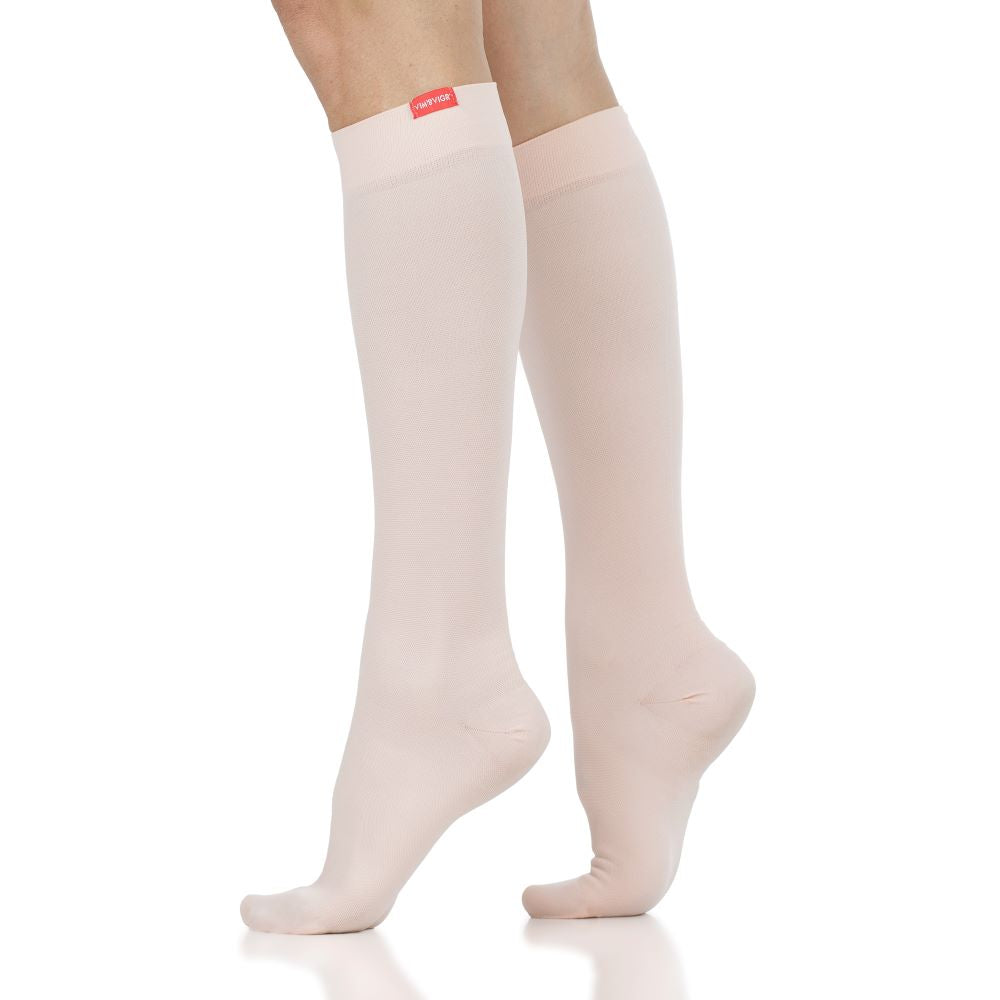Are Compression Socks Good for Pregnancy? 7 Key Benefits
Written By Alecsa Stewart
Scientifically Reviewed by Daniel Chantigian
Regardless of your age, fitness level, or medical condition, pregnancy can be hard on your body. During pregnancy there are significant changes in hormone levels and a 30-50% increase in blood volume. This often causes fluid retention in the blood vessels of the lower legs, which can cause painful swelling in the legs and feet, known as edema. Scientific research has found that 8 out of 10 pregnant women have edema during pregnancy. Edema during pregnancy often occurs in the lower legs. This can cause pain and affect sleep quality or even lead to circulatory problems like deep vein thrombosis.
Are compression socks good for pregnancy and, if so, why? Graduated compression socks and stockings provide great benefits for pregnant women. According to medical research, using compression socks during pregnancy may help you by:
- Effectively preventing edema
- Reducing leg pain (up to 30% less pain according to one medical study)
- Preventing deep vein thrombosis (especially when traveling)
- Reducing the severity of restless leg syndrome to improve sleep
- Reducing nausea and dizziness to improve quality of life.
There are also other health benefits, which we’ll cover below.
Are Compression Socks Good for Pregnancy?
Compression socks help relieve the pressure on blood vessels during pregnancy, while improving local blood flow and helping to prevent medical conditions like:
- Edema
- Venous Insufficiency
- Varicose Veins.
For pregnant women that have significant upper leg swelling, full-leg compression stockings can be used to reduce leg swelling, inflammation, and pain.
Why Are Compression Socks Good for Pregnancy?
A pair of compression socks or stockings may already be on your list after discussing pregnancy comfort with your doctor. These garments are often recommended to reduce circulatory problems, like blood clots and deep vein thrombosis, thanks to how compression can enhance blood flow, according to scientific research. And there are even more benefits!
Vim & Vigr compression socks are graduated, which means they are tighter at the ankles and slowly release the grip as they climb up the lower legs. The great benefit of this is that blood flow is stimulated to help it return to the heart. This is particularly important during pregnancy because the overall volume of blood in your body increases by 30 to 50%. Your heart and blood vessels therefore must deal with more blood than ever, which can become problematic in the face of gravity and if you already have vascular problems. The design of graduated compression socks supports the blood vessels by helping blood volume move back to the heart and through your body instead of pooling in your feet and legs.
Benefits of Compression Socks for Pregnancy
Not only do graduated compression socks play an important role in maintaining a healthy circulatory system during pregnancy, they are also great for reducing nausea and dizziness, soothing your joints and muscles, and preventing pain.
1. Reduce Swelling, Pain, and Cramps in Legs and Feet
As we mentioned before, 80% of women experience edema during pregnancy. Leg cramps are also extremely common with nearly 75% of pregnant women experiencing leg cramps according to this study. The extra fluid in your body during pregnancy often leads to swelling and discomfort in the legs and feet. Especially for pregnant women who are on their feet a lot at work, edema (accumulation of fluid into the tissues, usually in the lower leg veins) is a serious concern.
Swollen legs and feet during pregnancy are uncomfortable, and this swelling can lead to pain that reduces your quality of life. They also increase the risk of infections, ulcers, skin problems, and more. Edema makes it more painful to walk, which can affect your fitness levels and your overall well-being. However, wearing graduated compression socks will help with this.
One research report found that, in pregnant women, compression stockings reduce the risk of problems related to edema by 25%. Graduated compression socks are tighter around the ankles and slowly release pressure moving up the leg. Graduated compression is known to prevent the accumulation of fluid in peripheral blood vessels, especially in the legs. They also support the legs when walking and sitting for a long time, preventing any discomfort.

For relief from swelling during pregnancy, explore Vim & Vigr maternity compression socks.
2. Improve Circulation
It is not just lower leg circulation that can become a concern during pregnancy. If you struggle with peripheral blood flow, you can experience uncomfortable conditions like pins and needles or numbness. Moreover, as the fetus grows, more pressure is placed on the blood vessels throughout the body. Finally, specific changes in hormones during pregnancy increase women’s risk of blood clots by up to 500%. This can lead to deep vein thrombosis, varicose veins, and other problems with blood flow.
By the support they provide for lower leg veins and their action to prevent blood pooling, compression socks reduce the risk of blood clots and contribute to healthier circulation, which may help prevent blood clots according to clinical research.
3. Improve Comfort During Long Periods of Sitting or Standing
Being pregnant does not mean you will completely change your lifestyle or everyday activities. For many of us, work involves either sitting down for long periods of time at a desk or standing and walking (e.g. in a hair salon, shop, or school). This places pressure on the lower leg veins as the body becomes heavier with pregnancy weight gain and as it grows, which adds pressure on the circulatory system.
Any type of profession can therefore benefit from a boost in lower leg circulation and energy levels. Wearing graduated compression socks gives extra support to the joints and lower leg muscles. It also helps take some pressure off the legs. And, most importantly, these garments increase blood flow out of the legs (up to 24% according to one study) and reduce edema and pain. This will help you be more comfortable and energized while sitting or standing for long periods of time.

Discover pregnancy compression socks that help relieve aching limbs and improve your energy levels.
4. Preven Varicose Veins
According to the Cleveland Clinic, hormone changes and an increase in body weight contribute to the increased risk of developing varicose veins when pregnant. Varicose veins appear when the walls and valves of the veins are weakened, which can cause blood to leak from the veins and pool in the limbs. The result is the lumps we notice on the lower legs, which can also become painful and lead to legs feeling itchy or cramping.
Graduated compression socks take pressure off the blood vessels and stimulate blood flow out of the legs and towards the heart. They reduce some of the impact of walking and landing on hard surfaces, which also benefits the lower leg veins and muscles. Finally, preventing blood from pooling in the lower leg veins reduces the risk of them becoming damaged.
5. Lower Risk of Deep Vein Thrombosis (DVT)
We’ve seen that pregnancy increases the risk of developing blood clots by nearly 500%, according to a clinical report. When blood clots develop in the deep veins of the legs, this can cause deep vein thrombosis (DVT), which leads to intense pain, swelling, discomfort, and other medical problems. In extreme cases, a blood clot can travel to the lungs where it can block blood flow and cause a pulmonary embolism, which is life threatening.
Maintaining a healthy circulatory system and avoiding the development of blood clots is key for preventing DVT. Graduated compression socks apply gentle pressure to the limbs to help stimulate blood flow and reduce the risk of either condition. If, however, you still develop DVT, compression socks are also helpful. They soothe the pain in the legs, boost blood flow to keep from further swelling and discomfort, can bring down inflammation and pain, and may prevent severe complications.

6. Reduce Symptoms of Restless Leg Syndrome (RLS) to Improve Sleep
Women frequently experience restless legs syndrome (or Wilis-Ekbom disease) during pregnancy. Research has found that restless leg syndrome is common in pregnant women with up to 34% experiencing it. The name of RLS is misleading - rather than a disease, it is a term for when you feel like you want to always move your legs or if you often feel discomfort in your legs when sitting or lying down for a long time.
The good news is that, according to medical research, compression socks reduce restless leg syndrome symptoms by 50%, improve quality of life, and improve sleep quality to reduce daytime sleepiness for pregnant women. Because of their soothing compression, socks or stockings apply a constant sensory input to the legs, which one research study theorizes to be a way that compression improves restless leg syndrome symptoms.
Another issue that affects sleep in pregnant women is leg cramps, which nearly 75% experience. Thanks to how they improve blood flow and reduce swelling, compression socks and stockings may help reduce leg pain to help you sleep better at night.
7. Stylish and Functional Support
One last, but important, benefit of wearing Vim & Vigr graduated compression socks is the stylish support. We have explained so far that compression garments are supportive and boost blood circulation, but many associate them with dull-looking, medical apparel. While you can certainly wear the “classic” nude socks, why not go for a pop of color and style in your pregnancy and maternity outfits instead? This will lift your spirits, help you put together cute outfits to stay confident and positive, all while giving your circulatory system a much-needed boost.

Level up your pregnancy attire with stylish and functional compression socks.
How and When to Wear Compression Socks for Pregnancy
Compression socks are safe to wear for extended periods of time and can even be kept on when you go to sleep. They are ideal for improving comfort during long-haul flights and periods of immobility because they do not allow blood and fluid to pool around the ankles and cause swelling and discomfort. They are even a great accessory for physical activity during pregnancy, offering you extra support for the joints and muscles when you exercise.
During pregnancy, you may find that you want to keep your socks on all day long. You will benefit from improved circulation and better support, so there is no reason not to. The only advice we would give is that, if you have never worn compression clothing before, you may want to start off by testing them for over 2-3 hours on your first wear. Once you are used to your compression socks, you can gradually extend the length of time you keep them on.
As always, be sure to consult your medical practitioner to learn if compression socks are right for you and to determine what pressure you may need.
Finally, compression socks can be worn with any outfit. You can opt for some great alternatives that still give you therapeutic compression:
- Open-toe compression to wear with sandals and keep your toes aerated.
- Full-length compression tights or leggings for full-leg coverage and better support up to the pelvic area
- Calf sleeves to boost circulation in the area from the ankles to below the knee
The Best Compression Socks for Pregnancy
To find the best pair of compression socks for you, here are a few things to consider.
Size and Fit
Always ensure your socks are the right size for you, or you simply will not get the full benefits. Use a sizing guide where you match calf circumference against shoe size and adjust for widened calves during pregnancy. Your best compression socks are tight enough to boost circulation, but not so much that they become uncomfortable (and they do not roll down).
Choice of Fabric
When you are lounging and relaxing or during everyday activities, you will need different types of fabrics from when you work out or go for an energizing morning walk. At Vim & Vigr, we have a range of materials available to keep you comfortable and sweat-free:
- Cotton - for everyday wear, soft and relaxed feel
- Nylon - smooth and sleek, ideal for workouts
- Merino wool - antibacterial, thermoregulating, and super soft - ideal for hot days or for when you want to keep your feet warm.
If you’re concerned about seams rubbing or getting uncomfortable, pick our choice nylon range. For better sweat absorption, you can also choose moisture-wick nylon.
Compression Levels
Although all compression socks apply therapeutic pressure to the lower legs to boost circulation, they do not all feel the same. This is because there are three levels of compression to choose from:
- 15-20 mmHg for everyday wear and first-time compression wearers
- 20-30 mmHg for more advanced compression, especially if you already suffer from edema or varicose veins.
- 30-40 mmHg for medical compression, available on prescription from your doctor
Wearing compression socks during pregnancy can make a huge difference in how comfortable and energized your legs feel. With the increase in blood volume and the added pressure of weight on the legs, you will need support for your blood vessels and muscles, but also a soothing, massage-like feeling. This is where our high-quality graduated compression socks come in, relieving pregnancy symptoms and supporting healthy blood flow throughout your body.

References
Soma-Pillay, P., Nelson-Piercy, C., Tolppanen, H., & Mebazaa, A. (2016). Physiological changes in pregnancy. Cardiovascular journal of Africa, 27(2), 89–94. Read it here.
Davison J. M. (1997). Edema in pregnancy. Kidney International Supplement, 59, S90–S96. Read it here.
Saliba-Júnior, O. A., Rollo, H. A., Saliba, O., & Sobreira, M. L. (2022). Positive perception and efficacy of compression stockings for prevention of lower limb edema in pregnant women. Jornal vascular brasileiro, 21, e20210101. Read it here.
Allegra, C., Antignani, P. L., Will, K., & Allaert, F. (2014). Acceptance, compliance and effects of compression stockings on venous functional symptoms and quality of life of Italian pregnant women. International angiology : a journal of the International Union of Angiology, 33(4), 357–364. Read it here.
Clarke, M. J., Broderick, C., Hopewell, S., Juszczak, E., & Eisinga, A. (2016). Compression stockings for preventing deep vein thrombosis in airline passengers. The Cochrane database of systematic reviews, 9(9), CD004002. Read it here.
Mendoza, E., & Amsler, F. (2017). A randomized crossover trial on the effect of compression stockings on nausea and vomiting in early pregnancy. International Journal of Women's Health, 9, 89–99. Read it here.
Charles, T., Mackintosh, D., Healy, B., Perrin, K., Weatherall, M., & Beasley, R. (2011). Merino wool graduated compression stocking increases lower limb venous blood flow: a randomized controlled trial. Advances in therapy, 28(3), 227–237. Read it here.
Bamigboye, A. A., & Hofmeyr, G. J. (2006). Interventions for leg edema and varicosities in pregnancy. What evidence?. European journal of obstetrics, gynecology, and reproductive biology, 129(1), 3–8. Read it here.
Starling, A. P., Shapiro, A. L. B., Sauder, K. A., Kaar, J. L., Ringham, B. M., Glueck, D. H., Galan, H. L., & Dabelea, D. (2017). Blood pressure during pregnancy, neonatal size and altered body composition: the Healthy Start study. Journal of perinatology: official journal of the California Perinatal Association, 37(5), 502–506. Read it here.
Devis, P., & Knuttinen, M. G. (2017). Deep venous thrombosis in pregnancy: incidence, pathogenesis and endovascular management. Cardiovascular diagnosis and therapy, 7(Suppl 3), S309–S319. Read it here.
Wickham, N., Gallus, A. S., Walters, B. N., Wilson, A., & NHMRC VTE Prevention Guideline Adaptation Committee (2012). Prevention of venous thromboembolism in patients admitted to Australian hospitals: summary of National Health and Medical Research Council clinical practice guideline. Internal medicine journal, 42(6), 698–708. Read it here.
Gupta, R., Dhyani, M., Kendzerska, T., Pandi-Perumal, S. R., BaHammam, A. S., Srivanitchapoom, P., Pandey, S., & Hallett, M. (2016). Restless legs syndrome and pregnancy: prevalence, possible pathophysiological mechanisms and treatment. Acta neurologica Scandinavica, 133(5), 320–329. Read it here.
Kaplan, Ö., Başer, M., & Özgün, M. T. (2024). The effect of compression stockings on the complaints well-being and sleep quality of pregnant women with restless legs syndrome: a randomized controlled study. Revista da Associacao Medica Brasileira (1992), 70(7), e20240145. Read it here.


















Leave a comment